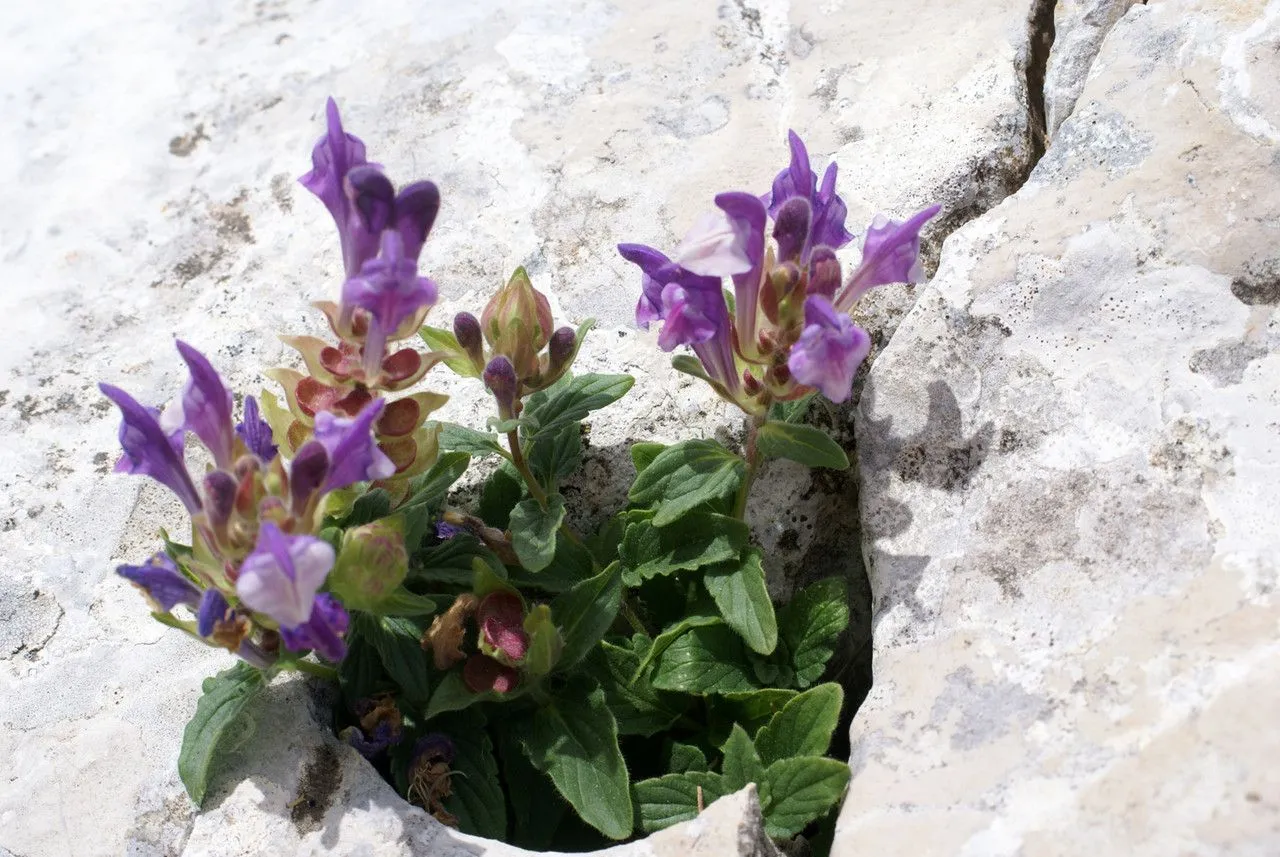
Author: L.
Bibliography: Sp. pl. 2:599. 1753
Year: 1753
Status: accepted
Rank: species
Genus: Scutellaria
Vegetable: False
Observations: SC. & S. Europe
Alpine scullcap (Scutellaria alpina) is a perennial herbaceous plant renowned for its distinctive attributes and natural beauty. Belonging to the Lamiaceae family, this plant is originally described and classified by the renowned botanist Carl Linnaeus in 1753.
Alpine scullcap thrives in the mountainous regions of Southern and Central Europe. The plant has adapted well to the alpine climate, making it a hardy addition to the diverse flora of these regions. It prefers rocky outcrops and limestone-rich soils where it can often be found flourishing in well-drained, sunlit environments.
This charming herb grows to varying heights, typically ranging from 10 to 30 centimeters tall. The leaves of Scutellaria alpina are simple, oppositely arranged, and have a distinctively oblong to ovate shape with a slightly serrated edge. The plant is known for its beautiful flowers, which exhibit a variety of colors from blue, violet, to occasionally white or pink hues, arranged in dense, terminal spikes. Each flower has a bilabiate corolla, typical of the Lamiaceae family, with an upper lip that is hooded, resembling a helmet, and a more open, lip-like lower part.
One of the striking features of the alpine scullcap is its ecological significance. It participates actively in its habitat by providing nectar for pollinators such as bees and butterflies, thus contributing to the biodiversity and stability of alpine ecosystems. The plant is not only a visual delight but also a vital component in sustaining the ecological balance in its native regions.
Alpine scullcap has also attracted interest for its potential medicinal properties. Traditionally, several species within the genus Scutellaria have been employed in herbal medicine, praised for their sedative and anti-inflammatory effects. While more research is needed, Scutellaria alpina may share similar therapeutic attributes, adding to its value beyond ornamental appeal.
In cultivation, Scutellaria alpina is appreciated for its low maintenance and robust growth, making it an excellent choice for rock gardens, alpine themed gardens, or even as ground cover in suitable climates. The plant prospers in well-drained soil and can withstand periods of drought once established.
In summary, alpine scullcap (Scutellaria alpina) stands out as a resilient and attractive member of the Lamiaceae family. Its charming flowers, adaptability to harsh alpine environments, and potential medicinal uses make it a noteworthy species both in the wild and in cultivated settings.
Deu: alpen-helmkraut
Swe: alpfrossört
Eng: alpine scullcap
Nno: alpeskjoldberar
Nob: alpeskjoldbærer
En: Alpine scullcap, Alpine Skull-cap, Alpine Skullcap
Bg: Алпийска превара
Ca: Escutel·lària alpina
Zh: 高山黄芩
Nl: Alpenglidkruid
Eo: Alpa skutelario
Fi: Alppivuohennokka
Fr: Scutellaire des Alpes, Toque des Alpes
De: Alpen-Helmkraut
El: Σκουτεραλία η αλπική
It: Scutellaria delle Alpi
Nb: Alpeskjoldbærer
Nn: Alpeskjoldberar
Es: Hierba de la celada, Tercianera, Tercianaria alpina
Sv: Alpfrossört
Zh-tw: 高山黄芩
Taken Jul 27, 2021 by Laurent Ledante (cc-by-sa)
Taken Jul 27, 2021 by Laurent Ledante (cc-by-sa)
Taken Jun 23, 2020 by michel-.gaubert (cc-by-sa)
Taken Jun 23, 2020 by michel-.gaubert (cc-by-sa)
Taken Jul 2, 2018 by orsatus (cc-by-sa)
Taken Jul 15, 2001 by Photoflora – Benoit BOCK (©)
Taken Jul 15, 2005 by Photoflora – Benoit BOCK (©)
Taken Jan 1, 1970 by Photoflora – L’Abbé COSTE (©)
Taken Jul 15, 2008 by Photoflora – Benoit BOCK (©)
Taken Jul 21, 2021 by huy HO (cc-by-sa)
Taken Jun 23, 2017 by Tela Botanica − Liliane ROUBAUDI (cc-by-sa)
Taken Jun 23, 2017 by Tela Botanica − Liliane ROUBAUDI (cc-by-sa)
Taken Jun 23, 2017 by Tela Botanica − Liliane ROUBAUDI (cc-by-sa)
Taken Jun 23, 2017 by Tela Botanica − Liliane ROUBAUDI (cc-by-sa)
Taken Jul 21, 2021 by huy HO (cc-by-sa)
Taken Jun 23, 2017 by Tela Botanica − Liliane ROUBAUDI (cc-by-sa)
Taken Jul 9, 2015 by Tela Botanica − Yoan MARTIN (cc-by-sa)
Taken Jul 15, 2009 by Tela Botanica − Alain BIGOU (cc-by-sa)
Taken Jun 20, 2017 by Tela Botanica − Jean-Jacques HOUDRÉ (cc-by-sa)
Taken Jun 23, 2017 by Tela Botanica − Liliane ROUBAUDI (cc-by-sa)
Taken Jun 21, 2019 by MICHEL DUSSERE (cc-by-sa)
Taken Jun 20, 2019 by MICHEL DUSSERE (cc-by-sa)
Taken Jul 15, 2001 by Photoflora – Benoit BOCK (©)
Taken Jan 1, 1800 by Tela Botanica − Thierry Pernot (cc-by-sa)
Taken Jul 4, 2018 by Přemysl Valeška (cc-by-sa)
Taken Sep 13, 2020 by Amel Hey (cc-by-sa)
Taken Oct 9, 2019 by Tela Botanica − Marie Portas (cc-by-sa)
© copyright of the Board of Trustees of the Royal Botanic Gardens, Kew.
© copyright of the Board of Trustees of the Royal Botanic Gardens, Kew.
© copyright of the Board of Trustees of the Royal Botanic Gardens, Kew.
Ph maximum: 8.0
Ph minimum: 7.5
Light: 8
Atmospheric humidity: 6
Soil nutriments: 3
Family: Myrtaceae Author: (F.Muell.) K.D.Hill & L.A.S.Johnson Bibliography: Telopea 6: 402 (1995) Year: 1995 Status:…
Family: Rubiaceae Author: Pierre ex A.Froehner Bibliography: Notizbl. Bot. Gart. Berlin-Dahlem 1: 237 (1897) Year:…
Family: Sapindaceae Author: Koidz. Bibliography: J. Coll. Sci. Imp. Univ. Tokyo 32(1): 38 (1911) Year:…
Family: Asteraceae Author: A.Gray Bibliography: Pacif. Railr. Rep.: 107 (1857) Year: 1857 Status: accepted Rank:…
Family: Fabaceae Author: Medik. Bibliography: Vorles. Churpfälz. Phys.-Ökon. Ges. 2: 398 (1787) Year: 1787 Status:…
Family: Aspleniaceae Author: (Cav.) Alston Bibliography: Bull. Misc. Inform. Kew 1932: 309 (1932) Year: 1932…